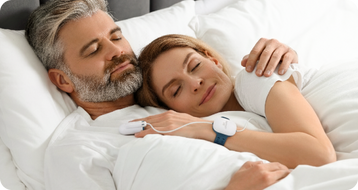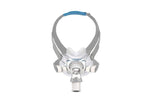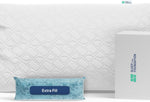On This Page
CPAP Masks for Side Sleepers
Our editorial process includes extensive measures to verify accuracy, provide clarity on complex topics, and present factual information. Read more
Key Takeaways
- Side sleepers benefit most from low-profile masks like nasal pillows or compact nasal masks, which minimize bulk and pressure on the face while sleeping.
- Because side sleeping increases the risk of mask movement and air leaks, a secure fit, flexible tubing, and stable headgear are essential for maintaining effective therapy.
- Accessories and adjustments, such as chin straps, CPAP pillows, and heated humidifiers, can significantly improve comfort and compliance for side-sleeping CPAP users.
Can You Sleep on Your Side With a CPAP?
Yes, you can sleep on your side while using a CPAP machine, but it can take some trial and error to find the right setup. While side sleeping helps keep your airway open naturally, this position can also make it harder to maintain a secure, comfortable mask fit throughout the night.
Compact and flexible designs—such as nasal pillows or minimal nasal masks—tend to work best, as they reduce facial contact and minimize pressure from the pillow. Larger full-face masks can press into the cheek or shift out of place and interrupting therapy.
And because side sleepers often change sides or sleeping positions during the night, mask movement and air leaks are common. That’s why it’s essential to choose a mask designed for side sleeping.
Types of CPAP Masks for Side Sleepers
The best types of CPAP masks for side sleepers are the nasal pillow and nasal mask styles. But the right mask also depends on an individual’s personal preferences.
It’s important to work with a doctor or sleep specialist and try a wide range of masks to find the style, model, and size that works best. Each side sleeper is likely to have their own comfort preferences to fit their unique facial shape. Experts agree that the best CPAP mask is the one a person is willing to use.
Nasal Pillow Masks
Nasal pillow masks are some of the most compact CPAP masks available. They consist of a soft, silicone pillow that sits just below the nose and fits into the nostrils to create a seal.
Pros
This style of CPAP mask is an excellent option for side sleepers. Nasal pillow masks are lightweight with a minimal footprint and can withstand the frequent movement of active sleepers. Their minimal design also makes nasal pillows a good choice for people who like to read or watch TV in bed before falling asleep.
Cons
Nasal pillow masks may not be appropriate for all side sleepers. These masks can be uncomfortable at pressure settings of 12 cm H2O or more. People with chronic nasal issues, such as a deviated septum or severe congestion, may do better with a different type of CPAP mask.
Nasal Masks
A nasal mask is a popular CPAP mask style that fits over the nose. These masks typically create a seal around the bridge of the nose and upper lip, but some models are more compact.
Pros
Nasal masks tend to work better at higher pressure settings than nasal pillow masks. As a result, nasal masks offer a good balance for side sleepers looking for a less bulky mask that can handle higher pressures. There are also many different models and sizes to choose from, making it easy to find a nasal mask that fits well.
Cons
Keep in mind that nasal masks have some of the same downsides as nasal pillow masks. For example, nasal masks may not work well for side sleepers with nasal issues.
Full-Face Masks
Nasal pillow and nasal CPAP masks are good choices for side sleepers, but certain people may want to consider full-face masks, which cover the mouth and nose and oral masks that only cover the mouth.
This style of mask is very common but tends to be bulkier than nasal pillow and nasal masks. However, full-face masks can work well for side sleepers who need a higher pressure setting or breathe through their nose.
Other Factors to Consider
When choosing a CPAP mask for side sleeping, comfort and stability are key—but there are several additional factors that can make a big difference in your nightly experience:
- Mask size and fit: A properly sized mask is essential for preventing air leaks and pressure marks. Look for adjustable headgear or memory foam cushions that conform to your facial shape.
- Tubing placement: Masks with a top-of-head hose connection can reduce tugging and make it easier to move freely during the night.
- Cushion material: Memory foam or soft silicone cushions can improve comfort for side sleepers by reducing pressure where the mask meets the pillow.
- Noise and air venting: If you sleep close to a partner, look for masks with quiet venting systems to minimize air flow noise and disturbance.
Best CPAP Mask for Side Sleepers
At Sleep Doctor, we've tested and evaluated countless CPAP masks to identify the ones best suited for people who sleep on their sides. The masks below stood out for staying secure, maintaining a reliable seal, and offering comfort in lateral positions.
- ResMed AirFit P10: This ultra-light nasal pillows mask weighs around 1.6 ounces and features QuietAir vents and a minimalistic design, making it ideal for side sleepers who want minimal facial contact and the freedom to move.
- ResMed AirFit N30i: With a top-of-head tubing connection and a cradle-style cushion that sits under the nose, this mask keeps the hose out of the way and supports side sleeping without compromising comfort or seal.
- Philips Respironics DreamWear Full Face: Designed for full-face coverage while still being side-sleeper-friendly, it features an under-the-nose cushion and top hose connection that reduces pillow interference and mask displacement.
CPAP Tips for Side Sleepers
Aside from your mask choice, you can use a variety of accessories and strategies to ensure your CPAP therapy is comfortable and effective.
Use a CPAP Pillow
A CPAP pillow can make a big difference in comfort and mask performance for side sleepers. Unlike standard pillows, CPAP pillows feature special cutouts or contours that reduce pressure on the mask and prevent it from shifting when you turn your head. This helps maintain a secure seal, minimizing air leaks and discomfort.
Many CPAP pillows also provide better neck and spinal alignment, helping you stay comfortable throughout the night.
Give Yourself Time to Acclimate
It’s natural to feel intimidated by CPAP therapy or worry that the treatment will be uncomfortable. Understand that it can take time to find a comfortable set-up that works for you. Be patient with yourself and allow plenty of time to adapt to your new CPAP treatment.
Health experts recommend setting yourself up for success with an initial adjustment period. Before jumping into sleeping with your mask on, practice taking your mask on and off and wearing it while awake. This will help you get used to wearing your mask and the feeling of pressure from your CPAP machine.
Prevent Mouth Leaks
Nasal pillow and nasal CPAP masks can be ideal for side sleepers, but these styles of masks don’t cover the mouth. If you tend to breathe through your mouth while you sleep, the pressurized air can easily escape before it has a chance to reach your upper airway.
To address mouth leaks while sleeping on your side, you can pair your nasal pillow or nasal mask with a chin strap. A chin strap helps hold your mouth closed to encourage nasal breathing and prevent mouth leaks. If a chin strap doesn’t work, consider using a full-face mask that covers both your nose and your mouth.
Address Nasal Dryness and Congestion
For side sleepers experiencing nasal dryness, health experts recommend using a heated CPAP humidifier. Many CPAP humidifiers on the market allow for customized temperatures. Users may need to experiment to find the most comfortable humidity and heat settings for their needs.
Nasal congestion is another common problem that can make it harder to breathe comfortably during CPAP therapy. For some people, medications such as topical or oral antihistamines can help relieve overnight congestion. Side sleepers with more severe nasal congestion may require a full-face mask instead of a nasal pillow or nasal CPAP mask.
Avoid Tangled Equipment
Active side sleepers may find themselves getting tangled in their CPAP tubing when they change positions or move around in their sleep. Most people, including side sleepers, change positions every hour or so as they sleep.
For active sleepers as well as side sleepers, a hose suspension system may be helpful. This CPAP accessory holds the CPAP tubing above the bed and away from the body, helping to prevent snags and tangles.
Talk to Your Doctor
Don’t forget to talk with your doctor or sleep specialist for individualized guidance. This is especially crucial in the first days and weeks of your CPAP therapy when you’re still getting used to your CPAP treatment.
Even if you’ve been using CPAP for a while, don’t hesitate to reach out to your doctor for help. Factors such as weight change may require mask resizing or adjustments to your pressure settings. However, don’t try to change the pressure settings on your CPAP machine without your doctor’s guidance.










